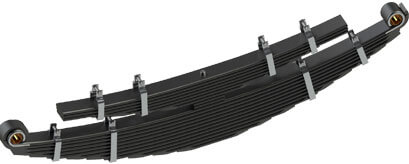
Heavy-duty trucks and commercial vehicles form the backbone of industries worldwide, transporting goods and people across vast distances. One critical component that plays a pivotal role in ensuring the stability, load-bearing capacity, and overall performance of these robust vehicles is the conventional leaf spring suspension system.
The suspension system of heavy-duty trucks and commercial vehicles is engineered to withstand the immense challenges posed by long-haul transportation, uneven terrains, and substantial cargo loads. Conventional leaf springs, a time-tested and reliable technology, continue to dominate this sector, offering a unique set of advantages.
Anatomy of Conventional Leaf Springs
Conventional leaf springs consist of multiple layers or leaves of spring steel bound together to form a single unit. These springs are attached to the vehicle’s chassis and axle, providing support and absorbing shocks generated by road irregularities. The layers, varying in length and thickness, contribute to the spring’s flexibility and load-bearing capabilities.
Load-Bearing Capacity
One of the primary functions of conventional leaf springs in heavy-duty trucks is managing the weight and load distribution. The design allows these springs to handle substantial loads, making them ideal for commercial vehicles that frequently transport heavy cargo. The layered structure ensures that the weight is evenly distributed across the axle, preventing excessive stress on individual components.
Stability and Control
Conventional leaf springs play a crucial role in maintaining stability and control, especially during high-speed maneuvers or when navigating challenging terrains. The springs resist lateral forces, preventing excessive swaying or tilting of the vehicle. This stability is essential for ensuring driver confidence, passenger comfort, and overall road safety.
Durability and Reliability
In the demanding world of heavy-duty transportation, durability is non-negotiable. Conventional leaf springs are known for their robustness and resistance to wear and tear. The simplicity of their design, with fewer moving parts compared to other suspension systems, contributes to their reliability and ease of maintenance.
Adaptability to Various Terrains
Heavy-duty trucks and commercial vehicles often traverse diverse landscapes, from smooth highways to rugged off-road terrains. Conventional leaf springs exhibit a remarkable ability to adapt to different conditions. The layered structure allows for sufficient flex, ensuring that the wheels maintain contact with the road surface even in challenging environments.
Cost-Effectiveness
Another factor contributing to the widespread use of conventional leaf springs in heavy-duty applications is their cost-effectiveness. The manufacturing process is relatively straightforward, and the materials used are durable and readily available. This translates to a lower overall cost, a crucial consideration for fleet operators and businesses managing large vehicle fleets.
Maintenance and Reparability
While heavy-duty vehicles endure harsh conditions, they are not immune to wear. The simplicity of conventional leaf springs simplifies the maintenance and repair processes. Individual leaves can be replaced or added to adjust load-bearing capacity without extensive downtime or costly repairs.
Innovations in Leaf Spring Technology
Despite their longstanding presence, conventional leaf springs have not remained stagnant in terms of technological advancements. Manufacturers continue to innovate, introducing variations such as parabolic leaf springs that offer a more progressive spring rate, enhancing ride comfort and load-carrying capabilities.
Challenges and Considerations
While conventional leaf springs have proven their worth in heavy-duty applications, they are not without challenges. The rigidity of the suspension system, while beneficial for load-bearing, can result in a slightly stiffer ride compared to other systems. However, ongoing research and development aim to address these challenges, striking a balance between load capacity and ride comfort.
Environmental Considerations
In an era where sustainability is a growing concern, the environmental impact of transportation technologies comes under scrutiny. Conventional leaf spring , primarily made of steel, are recyclable, contributing to the eco-friendly aspects of heavy-duty vehicle design. The recycling process helps reduce the demand for raw materials and minimizes the carbon footprint associated with manufacturing.
In the intricate tapestry of heavy-duty truck and commercial vehicle design, conventional leaf springs emerge as a resilient and indispensable element. Their ability to handle heavy loads, provide stability across various terrains, and offer cost-effective solutions makes them the preferred choice for many industries. As technological advancements continue, the role of conventional leaf springs in shaping the future of heavy-duty transportation remains pivotal, ensuring that these vehicles continue to navigate our roads with strength, stability, and reliability.